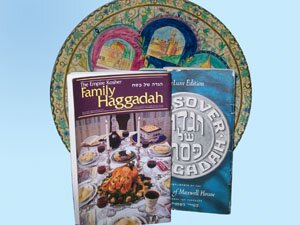| Why is this Haggadah different from all other Haggadot? |

|

|
|
Haggadah or “the telling” finds its roots in the verse, “You shall tell your children on that day: it is because of what the Lord did for me when I came forth out of Egypt.” (Exodus 13:8) Unlike other texts, the Haggadah can not be attributed to a single author or period of time. It is a beautiful tapestry of Jewish prayer, thought, refl ection, song, and artistry. The modern Haggadah contains not only passages from many sources but also detailednstructions on how to conduct a Seder. In addition to the inclusion of the prayers for after the meal, there are the songs that have become a part of our Pesach traditions. Often included are a number of commentaries by different Talmudic scholars and prayers for Israel as well as prayer for Remembrance of the six million.
It is not know when exactly the first Haggadah was complied, but it is believed to be sometime between the Mishnaic and Talmudic periods. Rabbi Yehudah bar Elaay, including in the Haggadah’s teachings, lived around 170 CE, therefore placing the date of its creation certainly sometime after that. Other sources cite the Middle Ages as the date for the Haggadah’s creation. There are a number of texts that delve deeply into this debate. The first printed Haggadot were believed to have been produced in 1482, in Spain, but this is assumed by reference only. The oldest confi rmed printed Haggadah was from Italy in 1486 by the Soncino family. A complete and readable manuscript of the Haggadah was found within a prayer book compiled by Saadia Gaon in the tenth century. By the end of the sixteenth century, only twenty-five Haggadah editions had been printed.This number increased to thirty-seven during the seventeenth century, and 234 during the eighteenth century. By the nineteenth century, 1,269 separate editions were produced and from there the numbers have climbed rapidly. Now the number far exceeds 2,000 editions. Growing up, I was led to believe that there was only one Haggadah, the muted blue covered Maxwell House Coffee edition. Given for free with the purchase kosher products, my family and neighbours hoarded copies of these. I have come to discover the thousands of other Haggadot in circulation- Haggadot for the Orthodox, the Progressive, the Conservative, the Reconstructionists, the Lubavitch and everyone in between. There are Haggadot for families, for feminists, for recovering addicts, for children, for singles, for atheists, for vegetarians… There are Haggadot to commemorate virtually every historic event imaginable. An entire study can be devoted to the critique of the artwork on Haggadot as well. The fi rst illustrated printed Haggadah was produced in Prague in 1526. Other earlier editions made use of illustrations but not as extensively as support for the text itself. There is the downloadabl 30minute-Seder™Haggadah that, “Blends Brevity With Tradition” and according to its creators, a “must have Haggadah for Passover 2008!” I have even been forwarded numerous online versions of a Two Minute Haggadah- A Passover Service For The Impatient, by Michael Rubiner. I am hoping that one though was just a joke. The establishment of the State of Israel has had a profound effect on the development of the Haggadah, as we are no longer only a Diaspora people. As expected, Israel’s 60th anniversary of its independence has produced a number of ‘collector’s editions’ already. At the end of the Seder, no matter which Haggadah we chose (two minute version aside), we all end with the same verse. “The following year grant us to be in Jerusalem.” While parts of the Haggadah are snapshots of a time in history, when boiled down- time is frozen and the tradition is as strong as ever. The Haggadah is our past, our present and our future. This Haggadah is not really different from all other Haggadot.
|


















